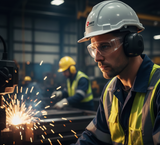From Compliance to Commitment: How to Build a Strong Workplace Safety Culture
Every business understands the necessity of workplace safety compliance. We follow the regulations and provide the necessary equipment. But simply meeting minimum requirements isn't enough to truly protect your employees and your business. The real magic happens when safety transcends a checklist and becomes ingrained in your company's DNA—when you shift from mere compliance to a genuine commitment to safety.
This is the essence of a strong workplace safety culture: where safety is a shared value, a collective responsibility, and an active part of daily operations for everyone, from the CEO to the newest hire. It’s the difference between avoiding fines and actively preventing harm, boosting morale, and enhancing overall productivity.
At Your Safety Company, we believe that robust safety isn't just about the products you use; it's about the principles you uphold. Let’s explore how to cultivate a safety culture that truly thrives.
What is a Safety Culture, and Why Does it Matter?
A safety culture is the shared attitudes, beliefs, perceptions, and values that employees share in relation to safety in the workplace. In a strong safety culture:
-
Safety is a priority, not an afterthought.
-
Everyone feels responsible for safety.
-
Hazards are reported and addressed promptly.
-
Learning from incidents is continuous.
-
Employees feel empowered to speak up about unsafe conditions.
Why it matters: Businesses with strong safety cultures experience:
-
Fewer accidents and injuries: A direct reduction in human suffering and associated costs.
-
Lower workers' compensation costs: Directly impacting your bottom line.
-
Increased employee morale and engagement: Employees feel valued and protected.
-
Higher productivity and quality: A safe environment fosters focus and efficiency.
-
Improved reputation: Attracts better talent and builds customer trust.
Building Blocks of a Strong Safety Culture
Cultivating a robust safety culture is an ongoing journey, not a destination. Here are key strategies:
-
Leadership Commitment & Visibility:
-
Lead by Example: Safety starts at the top. Leaders must visibly prioritize safety, adhere to all rules, and participate in safety initiatives.
-
Communicate Consistently: Regularly discuss safety in meetings, company communications, and one-on-one interactions. Make it clear that safety is a core value.
-
Allocate Resources: Provide the necessary budget, time, and personnel for safety programs and essential equipment.
-
-
Employee Involvement & Empowerment:
-
Safety Committees: Establish committees with representation from various departments.
-
Hazard Reporting: Create easy, non-punitive ways for employees to report hazards or near misses. Act on these reports promptly and visibly.
-
Feedback & Suggestions: Actively solicit employee input on safety procedures and improvements. Who better understands the risks than those on the front lines?
-
Stop Work Authority: Empower employees to halt work if they perceive an immediate danger.
-
-
Comprehensive Education:
-
Beyond the Basics: Ensure education goes beyond just "checking the box." Make it engaging, relevant, and hands-on, covering topics from proper PPE use to emergency procedures.
-
Continuous Learning: Safety education should be ongoing, not just during onboarding. Address new hazards and incorporate lessons learned from incidents.
-
-
Effective Communication & Transparency:
-
Open Dialogue: Foster an environment where employees feel comfortable discussing safety concerns without fear of reprisal.
-
Share Learnings: Transparently communicate the results of incident investigations, near misses, and corrective actions taken.
-
Safety Messaging: Use visual aids, posters, and digital communications to reinforce key safety messages regularly.
-
-
Accountability & Recognition:
-
Fair Enforcement: Consistently enforce safety rules, ensuring accountability applies equally to all levels.
-
Positive Reinforcement: Recognize and reward individuals and teams who demonstrate exemplary safety behaviors, participate in safety initiatives, or identify hazards. This encourages desired actions.
-
Partner with Your Safety Company to Foster a Culture of Care
Building a strong safety culture is the most effective way to protect your people and your business. It transforms safety from an obligation into a fundamental aspect of your company's identity and success.
At Your Safety Company, we are more than just a supplier of essential safety products. We are your partner in creating a workplace where safety is not just a rule, but a shared commitment. By providing the right PPE and first aid solutions, we help lay the groundwork for a truly robust safety environment.
Don't settle for mere compliance. Visit yoursafetycompany.com today to explore our comprehensive solutions and discover how investing in the right tools and a strong safety mindset can cultivate a culture where everyone returns home safe, every day.
Ready to transform your workplace safety? Contact us for expert advice and solutions on building a committed safety culture!
Recent Posts
-
Beyond the Big Box: Why Yoursafetycompany.com is the Smarter Choice for Your First-Aid Program
When it comes to workplace first aid, ensuring your business is compliant and your employees are pro …1st Jan 2026 -
The 2026 Safety Checklist: Is Your Crew Truly Protected?
As we move into the new year, it’s the perfect time to look past the daily grind and evaluate the ge …23rd Dec 2025 -
Beyond the Buzz: Why Proper Hearing Protection is Non-Negotiable on Your Job Site
On any given workday, the sounds of progress—drills, saws, heavy machinery, and even loud conversati …22nd Dec 2025



